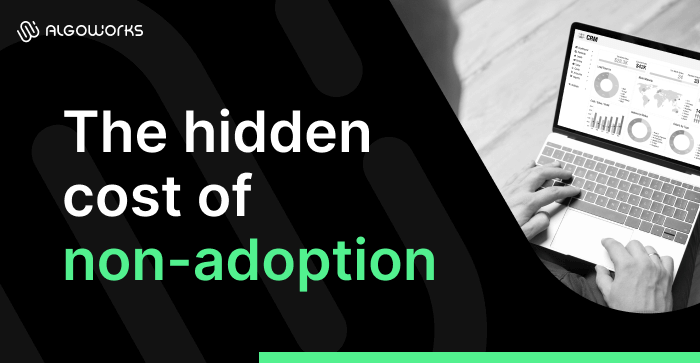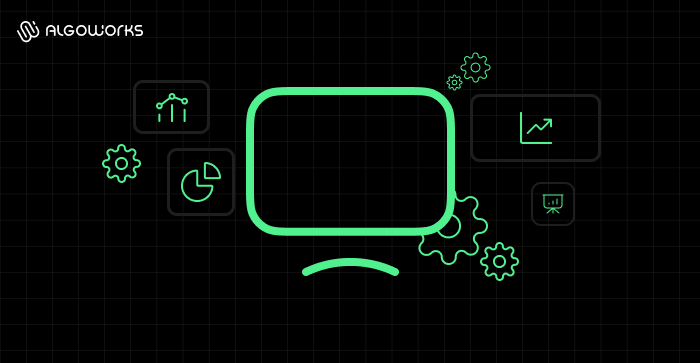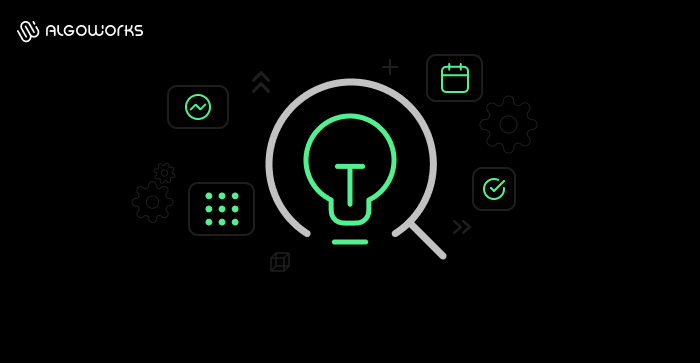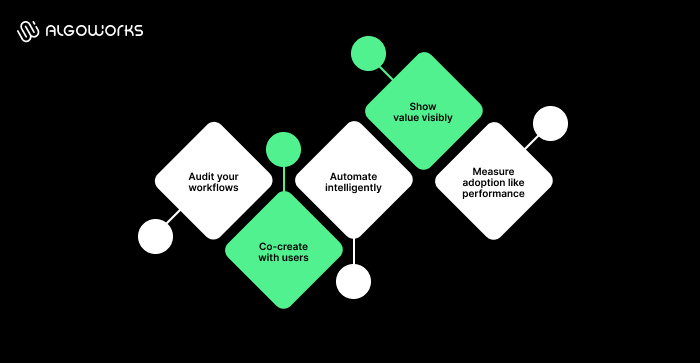The hidden cost of non-adoption: Driving Salesforce ROI by prioritizing employee experience

Salesforce isn’t broken; it’s being ignored.
Every skipped update, every unused dashboard, every rep working in a personal spreadsheet quietly drains ROI.
Salesforce adoption is an experience issue. And customer and employee experiences go hand in hand. When they’re designed together, they form service design – a unified approach that connects how employees work and how customers feel. If it feels disconnected from their daily work, they disengage.
And that disengagement is expensive.
- 70% of digital transformations fail primarily due to lack of Salesforce adoption and engagement (McKinsey).
- Only 33% of organizations report high Salesforce adoption rates within their teams.
- Poor user experience can reduce CRM productivity by up to 50%.
- Companies that invest in employee experience outperform others by 147% in earnings per share.
In this article, you will learn how to:
- Spot the hidden signs of non-adoption
- Redesign workflows that feel natural
- Build adoption by experience design
If employees struggle with Salesforce adoption, the business feels it; in revenue, forecasting accuracy and team confidence. This is where the real opportunity lies: designing Salesforce services adoption strategies around how people think, not how the system functions.
Let’s begin.
What’s at stake for leaders
When people work around Salesforce instead of within it, visibility collapses. Forecasts blur. Leadership loses the single source of truth needed for decisions.
Adoption failure isn’t caused by stubborn users; it’s caused by systems that don’t fit how people actually serve, sell and collaborate. Every friction point reduces data quality, slows execution and erodes trust.
That’s why improving Salesforce adoption starts with understanding the human layer; how people naturally move through their tasks and how the system can adapt to them.
Ask yourself:
- Are your teams using Salesforce as the heartbeat of work or as a reporting chore?
- If your data isn’t updated in real time, what exactly are your dashboards measuring?
Non-adoption doesn’t just block productivity; it distorts business intelligence.

Why Salesforce adoption fails: friction, not resistance
Many organizations respond to low adoption with more training. But training can’t fix a tool that doesn’t align with reality.
Employees don’t resist technology; they resist friction.
If Salesforce adoption feels like extra work instead of real help, people will find faster shortcuts. The friction is rarely dramatic; it’s the small, daily inefficiencies that pile up:
- Too many clicks to log a deal.
- Dashboards filled with fields no one uses.
- A process optimized for management, not for the people actually selling or serving.
- No clear “what’s in it for me” link between effort and outcome.
When Salesforce becomes something to feed instead of something that feeds back, disengagement follows and Salesforce adoption plummets.
Working with an experienced Salesforce Summit Partner helps uncover these friction points early, redesigning the experience before disengagement sets in.
Designing for adoption, not enforcement
Salesforce adoption by design starts with listening. Watch how sales reps move through a deal, how managers review progress and how service teams resolve issues. Map those actions before changing a single workflow.
Then design for flow, not enforcement.
- Simplify navigation. Surface what each role needs most and hide the rest.
- Automate repetition. Free people from data entry and manual reminders.
- Personalize dashboards. Give every user a view that reflects their goals, not someone else’s metrics.
- Close the feedback loop. Keep asking, what slows you down? what feels pointless? and fix it fast.
When the platform mirrors how people actually think and work, adoption stops being a push; it becomes a habit.
Just as important, invite employees into the build. When internal users help design the workflows, they feel ownership. They use what they’ve created because it reflects their daily reality. User research, both internal and external, is the quiet engine behind every great Salesforce adoption experience. It reduces the need for massive change-management efforts because the change was co-authored from the start.
The missing link: service design inside Salesforce
Customer experience improves only when the employee experience improves first.
Disjointed internal workflows inevitably surface as slow responses, fragmented updates and inconsistent service. Service design solves this by aligning front-office and back-office journeys, creating a single feedback loop between customers and teams.
Algoworks’ Define–Build–Run model operationalizes that alignment; define friction points, build around authentic user behavior and run continuous improvements that keep both experiences evolving together.

AI + Einstein: predicting friction before it happens
Modern Salesforce adoption is predictive. With Salesforce Einstein and AI analytics, leaders can spot friction before it shows up in missed targets. By combining behavior analytics, sentiment signals and workflow data, AI can:
- Flag when users are skipping steps or abandoning tasks.
- Recommend personalized guidance in-app.
- Predict which workflows will slow down performance next quarter.
Everyday AI services expand Salesforce Einstein capabilities, allowing organizations to detect Salesforce adoption drop-offs, automate recommendations and personalize the in-app experience. You can also see how this approach connects to broader enterprise planning in our Salesforce AI strategy blog.
This changes everything. Instead of reacting to disengagement, organizations can design out friction before it costs time, trust or revenue.
That’s how adoption evolves from a support challenge into a competitive advantage.
How experience-driven design transforms performance
When Salesforce adoption feels natural, teams engage without being told to. Reps update deals in real time because it helps them close faster. Managers rely on dashboards because they finally tell the truth. Service agents resolve issues faster because context lives where they need it.
Behind the scenes, continuous optimization powered by DevOps consulting ensures those workflows stay smooth as teams evolve.
The outcome:
- Cleaner data improves forecasting accuracy.
- Simpler workflows shorten sales cycles.
- Unified visibility gives leadership early insight into what’s working and what’s not.
Once Salesforce adoption is engineered into the experience, performance compounds on its own.

Action framework: 5 ways to improve adoption right now
- Audit your workflows. Sit with users. Watch where Salesforce adoption helps and where it slows them down.
- Co-create with users. Let teams shape the redesign; ownership fuels usage.
- Automate intelligently. Remove repetitive work so teams can focus on results.
- Show value visibly. Connect Salesforce data to wins and outcomes.
- Measure adoption like performance. Track engagement, satisfaction and workflow friction continuously.
For organizations pursuing long-term scalability, Salesforce integration services are a must to make sure that every connected system supports that adoption curve.
How Algoworks drives adoption by design
At Algoworks, Salesforce adoption is engineered into every implementation. Our Define–Build–Run approach ensures Salesforce evolves with your teams:
- Define: Map shadow workflows, identify friction points and align goals with user priorities.
- Build: Redesign interfaces, automate processes and integrate data for seamless experiences.
- Run: Deliver ongoing optimization, governance and in-context training that sustains engagement.
As a result, the Salesforce ecosystem that’s used daily, trusted fully and drives measurable business outcomes.
Ready to see where you stand?
Meet Algoworks at Dreamforce, where everyone talks about what’s next in Salesforce adoption and the real edge lies in what your people do with what you already have.
Book a 20-minute Adoption Triage with Algoworks. Leave with a 30-day roadmap to elevate employee experience and unlock real Salesforce ROI.
FAQs
1. Why do most Salesforce projects fail after implementation?
Because employees don’t actually use the system as intended. Most Salesforce failures aren’t technical; they’re human. When workflows feel clunky or disconnected from daily routines, people bypass the platform. That leads to poor data quality, weak visibility and lost ROI.
2. How does employee experience affect Salesforce adoption?
Employee experience drives whether people engage or avoid Salesforce. When the system feels intuitive, aligned to real tasks and reduces effort; adoption happens naturally. When it feels like extra work, even the best tech won’t save it.
3. What are the biggest barriers to Salesforce adoption?
The top barriers are workflow friction, too many clicks, irrelevant fields and lack of clear personal value (“what’s in it for me”). Most teams overemphasize training when the real issue is design misalignment.
4. How can AI improve Salesforce adoption rates?
AI tools like Salesforce Einstein help spot friction before it becomes failure. They track skipped steps, predict which users might disengage and offer in-app guidance. This turns Salesforce into a proactive assistant instead of a passive system.
5. What’s the best way to increase Salesforce adoption in my company?
Start by observing how your teams actually work. Simplify workflows, automate repetitive steps, personalize dashboards and let users co-design improvements. Adoption grows when Salesforce feels like it was built for them, not to them.

